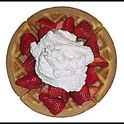I don't have a food processor. Would this recipe work with a stand mixer with paddle attachment or with bladed dough blender?

Recipe question for:
Cook's Country Pie Crust
5 Comments
ChefOnoNovember 14, 2013
Thanks for the link, Chris. And just in time for the height of pie season!
GreenstuffNovember 14, 2013
As I've followed this story over the years, Kenji doesn't so much use the vodka trick himself, feeling that just getting to know the feeling of the dough works for him. The step he's touting most is the more complete mixing of fat and some of the flour. That step is most easily accomplished by a food processor. The Genius Recipes column did a good job of explaining it, and you can read what I think is Kenji's own most recent article here http://sweets.seriouseats...
My own philosophy about pie crust is that you work and work and it never seems to come out right. Then you somehow get it and can do all the "wrong" things you thought you'd done earlier, but it works anyway. I guess that's what Kenji meant when he wrote about getting a feeling for the dough.
My own philosophy about pie crust is that you work and work and it never seems to come out right. Then you somehow get it and can do all the "wrong" things you thought you'd done earlier, but it works anyway. I guess that's what Kenji meant when he wrote about getting a feeling for the dough.
boulangereNovember 14, 2013
I'd feel much better about the recipe and method if it suggested you measure the "chilled solid vegetable shortening" with (a) some guidance as to what that means, and (b) how many ounces are required. Next, as Chef Ohno suggests, using a liquid which contains a minimal amount of water is also key, inasmuch as water contributes to the formation of gluten as your dough is mixed. To make a long story short, feel free to use a mixer fitted with a paddle to mix your pie pastry.
ChefOnoNovember 14, 2013
Indeed. Flaky pastry long predates the food processor. The magic is in the substitution of alcohol -- which doesn't promote the formation of gluten -- for water. That should have been explained (or did I miss something?)
RespectThePastryNovember 14, 2013
You would be much better off making the dough with a pastry cutter (or even two knives or forks). Using an electric mixer will overwork the proteins in your dough and will leave you with less than ideal dough texture.
Showing 5 out of 5 Comments
Recommended by Food52
Popular on Food52
Continue After Advertisement



